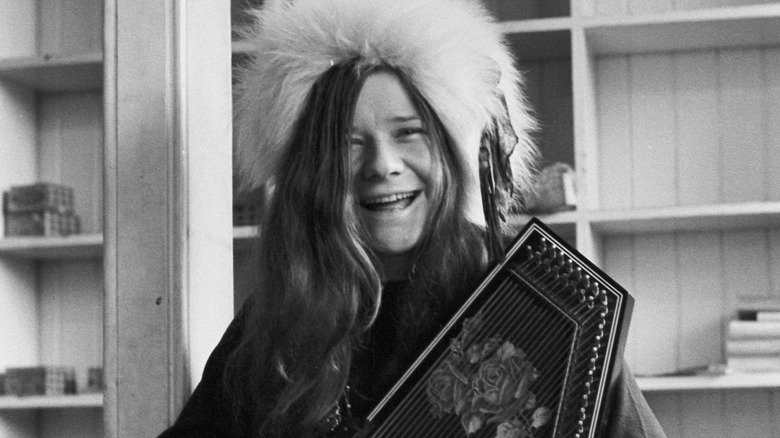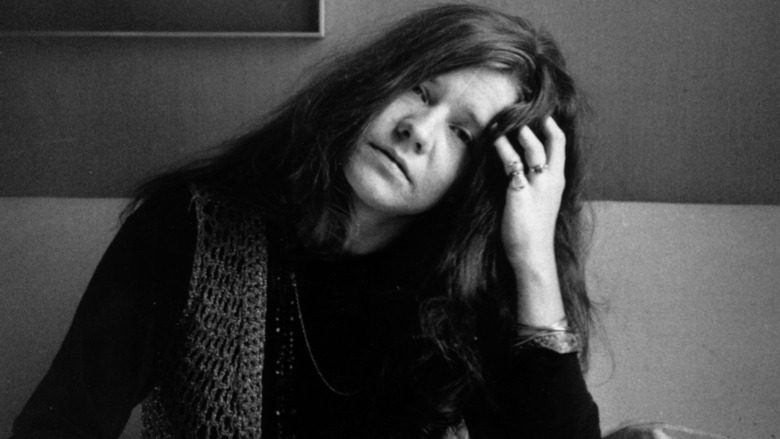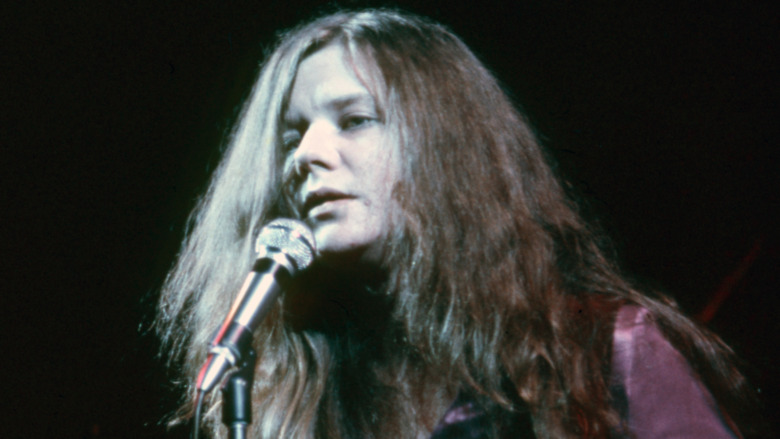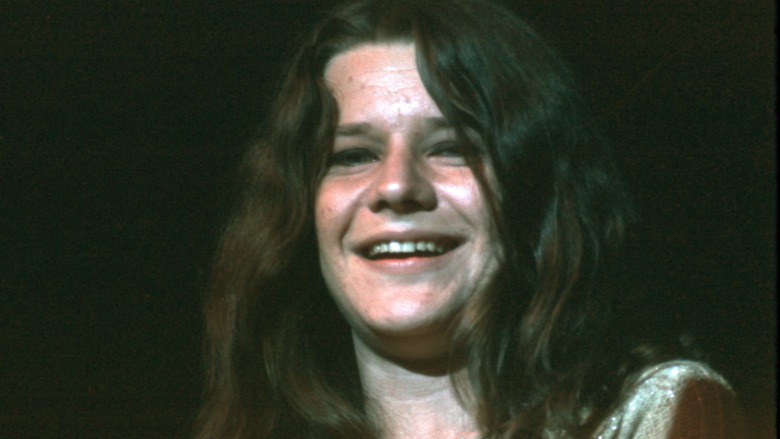The Tragic Death Of Janis Joplin
Janis Joplin was truly ahead of her time. In an era when female musicians were expected to be less intense and outspoken than their male counterparts, the Port Arthur, Texas, native shattered any preconceived notions of what was expected from a woman in popular music. Aside from belting it out onstage with unbridled passion and a much rougher voice than the average female vocalist of her time, Joplin didn't hold anything back offstage when it came to her larger-than-life persona. She openly had relationships with men and women, as noted by Far Out Magazine, and she wasn't afraid to throw down if the occasion called for it, as she infamously clobbered The Doors' frontman, Jim Morrison, with a bottle of Southern Comfort for drunkenly making advances on her at a party.
Unfortunately, the sex, drugs, and rock 'n' roll lifestyle caught up way too soon with Joplin, who died on October 4, 1970, of an accidental heroin overdose, joining a growing list of musicians and other entertainers who died at the young age of 27. Even sadder was the fact that at the time of her death, she was working on "Pearl," an album that would reach the top of the Billboard 200 and yield a posthumous No. 1 hit single in "Me and Bobby McGee." Here's the story of Joplin's tragic death, as well a look at the alleged circumstances that might have led to her fatal overdose.
Joplin was reportedly clean for half a year before her death
As recalled by Ultimate Classic Rock, Joplin was seemingly in a good place about a month before her death. Aside from the fact she was almost done with "Pearl," she enjoyed working with producer Paul Rothchild and making music with her backing group, the Full Tilt Boogie Band. She was also engaged to a man named Seth Morgan and, most importantly, clean for about six months as of September 1970, according to her road manager, John Byrne Cooke.
While everything seemed to be coming up roses for Joplin, she and her band happened to be staying at the Landmark Hotel in Los Angeles while she was recording "Pearl." For someone who had a known heroin addiction, this was the worst place to stay, as Byrds and Crosby, Stills, Nash & Young singer-guitarist David Crosby recalled in his autobiography, "Long Time Gone," that the Landmark was notorious for its "convenience of being close to the street dealers."
Cooke noted that Joplin's eagerness to work on what would turn out to be a classic album may not have been enough to keep her from scoring dope near her hotel. "There's things about recording that are boring even if you're real excited about your record producer. Even if you're really excited about the music and the band," he explained. "When Janis got bored she started dabbling again."
Joplin was supposed to record vocal tracks for Pearl on the day of her death
Everything still appeared to be business as usual for Joplin on the night of October 3, 1970, as she showed up at the studio to listen to the Full Tilt Boogie Band's backing track for "Buried in the Blues," per Ultimate Classic Rock. After telling Rothchild that she would be back the next day to record her vocal tracks, Joplin and her bandmates headed to Barney's Beanery for a few drinks. She then returned to the Landmark Hotel, but didn't show up the next day for the scheduled recording session.
Concerned by the singer's surprising absence, Rothchild phoned Cooke, who then attempted to get in touch with Joplin by calling her hotel room. The road manager drove to the Landmark after she repeatedly failed to pick up the phone, and it was in her hotel room where she was found "lying in an awkward position" with some money — four dollar bills and two quarters — in her hand and a pack of cigarettes on the side table. In his book, "On the Road with Janis Joplin," Cooke wrote that she appeared to have bought the cigarettes from a vending machine in the hotel lobby, returned to her hotel room, and "keeled over" with her head hitting the corner of the table before she could light one up. This explained the head wound that was spotted after her body was found.
Different theories have sought to further explain Joplin's death
Aside from how Joplin apparently had easy access to drug dealers at the time of her death, there have been a few other notable theories that sought to provide additional context to the tragedy. Laura Joplin wrote in "Love, Janis" (via Ultimate Classic Rock) that her sister purchased heroin on the afternoon before her death from a dealer named George, who usually asked a chemist to "check" the drug before selling it to anyone. But with the chemist being out of town that day, George unwittingly sold Janis a batch of heroin that was "40 to 50 percent pure," making it up to 10 times stronger than usual.
As for the reasons Joplin started doing drugs again after being clean for some time, her former Big Brother and the Holding Company bandmate Peter Albin claimed that the singer went back to using heroin because she was drinking much more than usual, and that "wasn't good" for her singing voice.
It has also been theorized that Joplin might have been stood up by the two people she was supposedly dating — her fiancé, Seth Morgan, and her on-again, off-again lover Peggy Caserta — shortly before her death. According to Far Out Magazine, the musician purportedly invited the two for a threesome "or at the very least, some fun," but when they failed to show up, she ultimately chose to do some heroin by herself — only to succumb to a fatal overdose.



